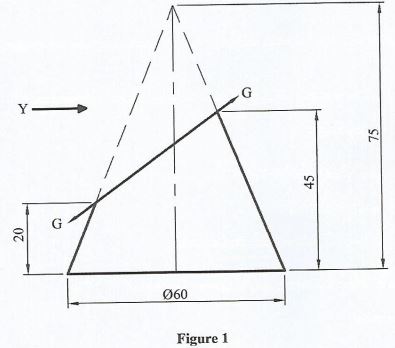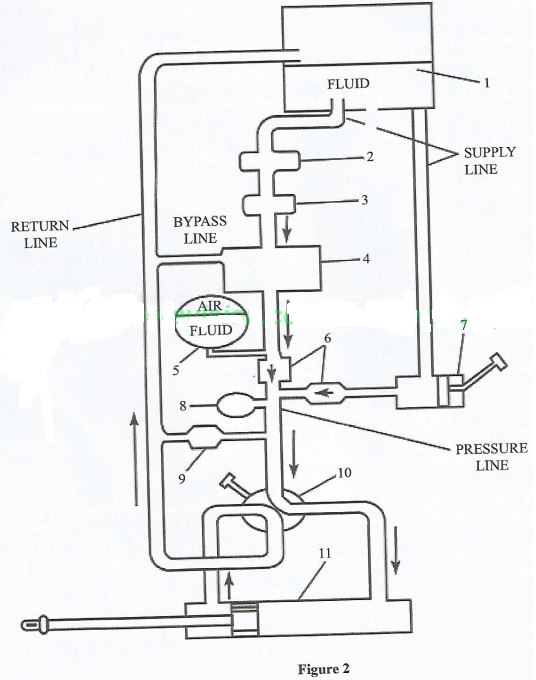| 1 |
Solution
- Assessing design requirements, maintenance.
- Measuring and improving the performance of aircraft, components and systems, repair.
- Assembling the aircraft or fitting components, manufacturing.
- Testing evaluating, modifying and retesting products/components.
- Writing reports, manuals and documentation i.e. tech log.
- Provide technical advice.
- Pre-flight checks. Any 3 x 1
|
(3marks)
|
| 2 |
Factors to consider in the location of fire extinguishers:
- Extinguishers should be sited on escape routes on all floors at what is called fire points (exit points).
- They should be fixed in a location where they can be reached quickly. The best place is near a door leading to a place of safety(accessibility)
- They should be fixed where they can be easily seen. Fixing them
inside cupboards or behind doors will waste valuable time, in case
of a fire i.e open place.
- Extinguishers must not be placed in places of extreme temperatures, hot or cold (conducive environment)
- Extinguishers should not be fixed at an elevated height, so that the handle is easily accessible from the floor for heavier units.
- They should be within reasonable distance from any fire risk areas
Any 4 x 1
|
(4marks)
|
| 3 |
- Class airspace
- All flights are provided with air traffic control service and are separated from each other(IFR only)
- Class B airspace
- All flights are permitted and are provided with air traffic control service and are separated from each other(Both IFR and VFR)
- Class C airspace
- All flights are permitted and provided with air traffic control service. IFR flights are separated from other VFR flights (Any 4x=2 marks)
|
(2marks)
|
| 4 |
Advantages of composite materials:
- High strength to weight ratio
- Longer life than metals (durable)
- High corrosion resistance
- High tensile strength than steel or aluminum (v) Easily repairable
- Eliminates joints and fasteners Any 3 x ½
Disadvantages of composite materials:
- Difficult to conduct inspections
- Very expensive processing equipment
- Product often toxic and hazardous
- Lack of standardized methods for construction and repair
- General lack of repair knowledge and expertise in using composites (vi)
- Expensive in cost as compared to metals Any 3 x ½
|
1½
1½
(3marks)
|
| 5 |
-
- Autogyro is a form of aircraft with freely rotating horizontal blades and a propeller. It differs from a helicopter in that blades are not powered but rotate in the strip stream, propulsion being by a
conventional mounted engine.
(autogyro-non powered, helicopter-powered)
- Glider is a light aircraft designed to fly without using an engine, whereas an ornithopter is a machine designed to achieve flight by means of flapping wings 2 x 2
-
- Skin friction drag is the result of the aircraft's surface being rough/ sharing effect of successive layers fair).
- Form drag is the result of an object's general shape in relation to the relative word
- Interference drag is generated by the mixing of airflow
streamlines between airframe components eg wing & free lance
3 x 1
-
- He laid down the principles of heavier than air aircrafts and defined a modern aircraft comprising of a fixed wing, fuselage & tail assembly
- Conducted demonstrations of manned, gliding flight
- Conducted experiments demonstrating drag and streamlining on an aircraft
- Set out principles of power-to-weight ratio in sustaining flight (v) Invented glides
- Designed helicopter, airships, aeroplane. 4 x ½
|
(4marks)
(3marks)
(2marks)
|
| 6 |
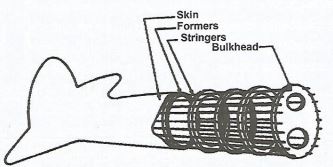
Sketching 1 x 2 = 2 marks
Labelling 4 x ½ = 2 marks |
(4marks) |
| 7 |
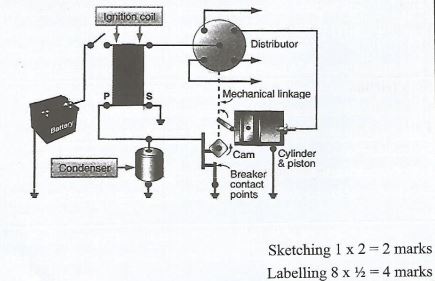 |
(6marks) |
| 8 |
-
- Machmeter - an instrument in an aircraft indicating airspeed as a mach number (airspeed in relation to speed of sound)
- Twin and slip indicator - an instrument that shows the rate of turn of an aircraft in degrees per second or coordinated turn
- Artificial horizon - an instrument that indicates to the pilot the aircraft orientation relative to the earth's horizon and gives an immediate indication of the smallest orientation change (pitching moments) 3x1
- Sources of fuel contamination:
- Water-these include free water on low spots in a pipeline, rain water leaking past the seals in floating-roof tanks
- Microbial growth-micro-organisms found in fuels include bacteria and fungi
- Particulates-This include air-bone solids that enter through tank vents or slip past the seals of floating roof tanks(dust and pollen) (iv)
- Petroleum products-mixing two grades of fuel in the tank. (v)
- Abrasives Any 2 x 1
|
(3marks)
(2marks)
|
| 9 |
- Hardening involves heating of steel, keeping it at an appropriate temperature and then quenching it rapidly in water or oil.
- Tempering involves heating steel that has been hardened and
quenching for an adequate period of time.
- Annealing involves heating steel up-to a high temperature, and then cooling it very slowly to room temperature.
- Normalizing involves heating steel, and then keeping it at that temperature for a period of time, then cooling in air. Any 4 x 1
|
(4marks)
|
| 10 |
- Very light and thin lines used to construct layout work.
- Long and short dash lines used to indicate center of holes, circles.
- Thin and dark line used to show the starting and ending (extend) of
dimensions.
- Medium live with arrowhead to shows notes or label for size or special information about and features. 4 x 1
|
(4marks)
|
| 11 |
-
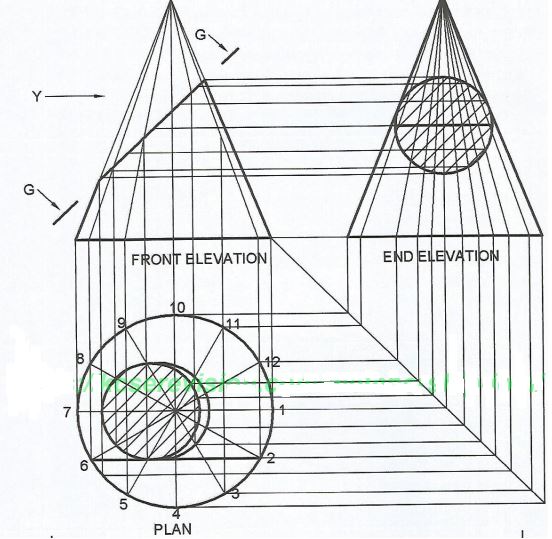
Copying the figure - 1 mark
Drawing the plan - 1 mark
Dividing plan into 12 divisions - 1 mark
Complete projection of points from plan - 1 mark
Projector from F points from FE to plan - 1 mark
Plotting of points of transaction to plan - 1 mark
Joining the points with a smooth curve - 1 mark
Hatching the face which is cut - 1 mark
8 marks
b.
Projecting points from F.E. to E.E. - 1 mark
Projecting points from F.E. plan to E.E. - 1 mark
Joining points to obtain E.E. outline - 1 mark
Plotting points to obtain the cut face - 1 mark
Joining the points to obtain the cut face - 1 mark
Hatching the cut face - 1 mark
14 marks
|
|
| 12 |
-
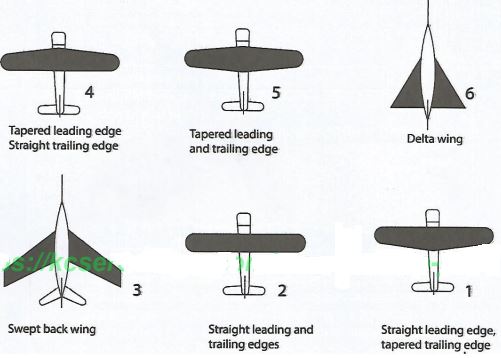
Sketching 6 x ½ = 3 marks
Naming 6 x ½ = 3 marks
TOTAL = 6 MARKS
-
| 1 |
Reservoir |
| 2 |
Power pump |
| 3 |
Fitter |
| 4 |
Pressure regulator |
| 5 |
Accumulator |
| 6 |
Check values |
| 7 |
Hard pump |
| 8 |
Pressure gauge |
| 9 |
Relief valve |
| 10 |
Selector valve |
10 x 1⁄2
-
- Winglet - a winglet is a vertical option of the wing's tip resembling a vertical stabilizer. It is an aerodynamic device designed to reduce the drag created by long tip vertices in flight
- Vortex generators-vortex generators are airfoils usually attached to the upper surface of a wing. They are designed to promote positive linear flow over the wing and control surfaces
- Stall fence - a stall fence is a chord divide barrier on the upper surface of the wing used to halt the span-wise flow of air. During low speed flight, this can maintain proper chord wise airflow reducing the tendency for the wing to stall. 3 x 1
|
(6marks)
(5marks)
(3marks)
|
| 13 |
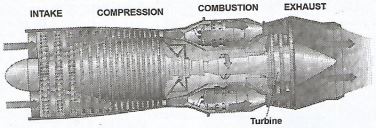
- At the intake, a large amount of air getting inside the engine is drawn into the rotating compressor
- At the compressor, the pressure of air increases by passing it through a series of rotating and stationary blades
- At the combustor, fuel is being injected into the conclusion chamber by the burner where the compressed air gets mixed and whole air
fuel mixture ignited to produce a high amount of heat energy in the combustion chamber
- At the turbine, the heated gas of the combustion chamber passes through the turbine it rotates the shift and it consumed very less energy
- At the nozzle, it restricts the flow-------before allowing gas to expand and thus it creates additional pressure that results in additional thrust.
Sketching 1 x 11⁄2 = 11⁄2 marks
labelling 5 x 1⁄2 = 21⁄2 marks
cycles 5 x 2 = 10 marks
|
(14marks)
|
| 14 |
-
- Clean the component to be inspected
- Remove paint
- Dry the component
- Apply penetrant
- Allow time for penetrant to sink
- Respect and interpret
- Wipe off the penetrant
- Apply developer
- Allow time for the developer to sink
- Remove the applied penetrant and developer
- Clean and restore the component
- Fill in the appropriate paperwork 12 x 1⁄2
-
-
- Proper use of logbooks and worksheets
- Ensure that maintenance personnel discuss exactly what has been and needs to be completed to the next shift
- Never assume that the work has been completed
- Do a proper handover
- Ensure radio communication
- Briefings
- Meetings
- Good listening skills 4 x 1⁄2
-
- Be aware of the symptoms of fatigue and look out for them
- Forfeit complex task if you know you are exhausted
- Eat healthy foods at regular intervals
- Exercise during free time
- Get enough sleep/rest Any 4 x 1⁄2)
-
- Only fix parts that you are trained for
- Ensure that the maintenance manual you are using is up to date If you don't know how to fix something ask for help
- Countercheck your work particularly on tasks you are not sure about
- Research/studying Any 4 x 1⁄2
-
- On returning on the job go back through all of the steps to ensure where you left off
- Use a detailed checklist
- Never leave tools or parts lying around
- Secure your area before leaving even if for a short while
- Alertness 4 x 1⁄2
|
(6marks)
(2marks)
(2 marks)
(2 marks)
(2 marks)
|
| 15 |
-
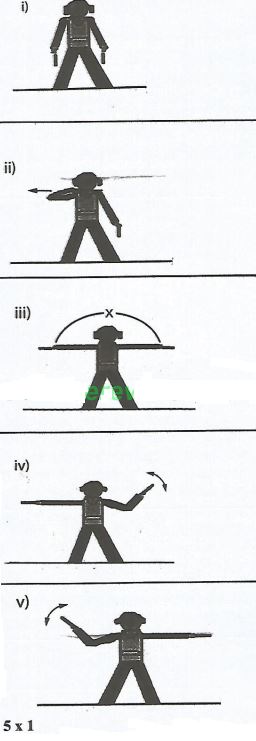
-
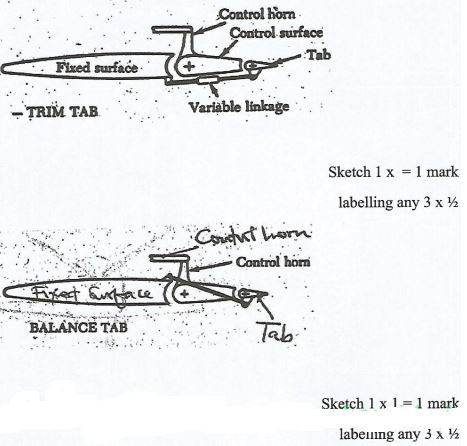
-
- Immediately get the person away from the source of heat
- Cool the burn with cool or lukewarm water for 20 minutes
- Remove any clothing or jewelry that is near the burnt area of skin
- Make sure the person keeps warm
- Cover the burn by placing a layer of clean film over it
- Use painkillers such as paracetamol or ibufen to treat the pain
- If the face or eyes are burnt sit up as much as possible, rather than lying down to reduce swelling Any 4 x 1
|
(5marks)
(2½ marks)
(4 marks)
|



